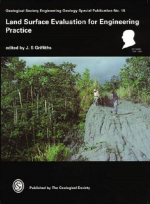Добрый день, Коллеги. Важное сообщение, просьба принять участие. Музей Ферсмана ищет помощь для реставрационных работ в помещении. Подробности по ссылке
Land surface evaluation for engineering practice / Инженерно-геологическая оценка земной поверхности
The First Working Party Report (Anon. 1982) defined 'Land surface evaluation' for engineering practice as: 'The evaluation and interpretation of land surface features and recorded surface data using one or a combination of the ground mapping, interpretation, classification and visual remote sensing techniques outlined in this report'. The techniques outlined in the report were land classification, remote sensing and geomorphological mapping. The expression 'land surface evaluation' was adopted in preference to 'terrain evaluation' or 'terrain classification' because the varied uses of the terms had created confusion and led to misunderstandings. For this same reason in this Second Working Party Report the expression 'land surface evaluation' has been maintained. Developments since the 1982 Report was published require revision to the definition of 'land surface evaluation'. The definition proposed by the Second Working Party is:' Theevaluation and interpretation of land surface and near surface features using techniques that do not involve ground exploration by excavation or geophysics'. This rather broader definition allows land surface evaluation to be seen in its most common context as the process of data compilation, interpretation and conceptual ground modelling prior to undertaking engineering ground or site investigation work. It therefore specifically includes the integration of all existing ground information (desk study) whether it is surface or subsurface information.
The first objective of a land surface evaluation study is to acquire the most comprehensive conceptual ground model that can be generated in order to maximize the value and justify the cost of subsurface investigation fieldwork and allied laboratory testing. The second objective is to minimize the engineering geological unknowns that currently generate disproportionate unforeseen contractual costs and not infrequently jeopardize the in-service facility or its design life. <...>




